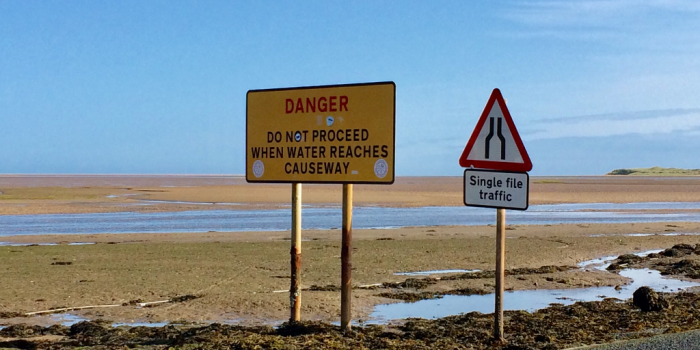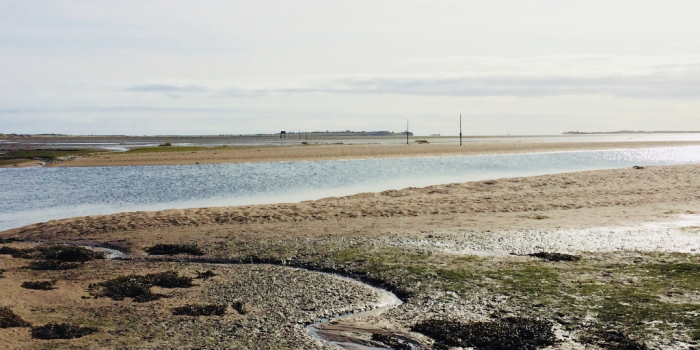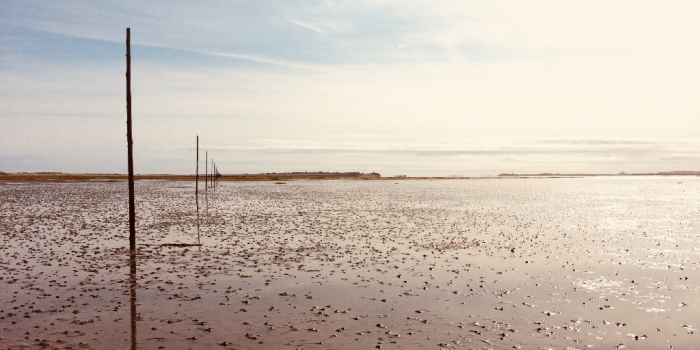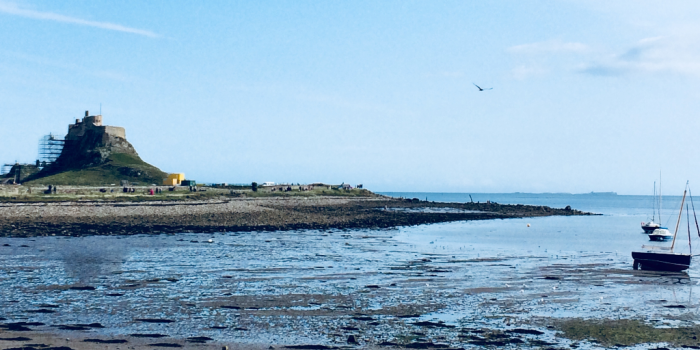When we arrived at Dunstan and walked down to the castle, I heard them. Unmistakably alien-sounding and causing a quick lance of joy in my chest: the seagulls were hawking their cries. Though gulls are ubiquitous almost everywhere these days, encroaching onto the thin, begrudging borders of our towns – wheeling over dumps and nuisancing the outsides of eateries – there is a difference my ear cannot miss in the rationed and contained cries of the gulls inland and the vast ache of cry the seagull emits on the wing above the sea. The sea wind does something in carrying this cry that enlarges it. Its voice fills an emptiness I did not know I was carrying around inside me, like a faint echo. The sea, the sea.
I have hoarded a desire to see the sea for a while now, having been absent from it for 23 months. Waves have been frozen in my mind; a restless sea halted without me to dip my toes into it. This week on the Northumberland coast, the sound of the sea haunts me at night, delivering restless visions. I listen to sterile digital waves in the wee hours of the morning to conjure sleep when it doesn’t come, buzzed from seeing so much of my family on this holiday to celebrate my dad’s 70th. My mind’s eye sees the sea spume, and the white membranes stretched like a sheep’s caul across the bob and lift of the waves. I lie awake feeling wired – all too aware of the sea no more than a mile distant – the knowledge of it like a whelk shell pressed to my ear. Now, today, I will walk the sea floor and I’m dumb with awe before it. Made a child again. The cries of the gulls interpret for me how wide and fathomless are the sea and sky. My soul has missed them.

I had decided weeks ago that I wanted to walk out to Lindisfarne, knowing that I could at the very least walk the causeway but hungry for a walkers’ counterpart to the road. A little research yielded fruit – the Pilgrim Way has been the footway in use since before Aidan first came here in the 7th century (that was when the original set of 15ft way-finding poles was erected). The “path” is navigable when the tide is out and has 2 refuge stations en route which resemble treehouses on stilts (in case of need). I possess a map, advice and tide times (and a healthy dose of well-meant familial concern about the wisdom of walking out to sea, which of course serves only to strengthen my determination).
Like one arm of a tuning fork, the Pilgrim Path veers away from the causeway and out into the silty and part-submerged sandlands of Beal Bay. The mainland curves in the distance down towards Bamburgh on the right, and the causeway leading to Lindisfarne’s Snook Point curves to the left, giving the illusion that you are in a land-locked lagoon, but for a small gap on the horizon straight ahead, between the southern tip of the Island and the twin Leading Lights. Fishermen use these “lights” to get their bearings when out in their fishing smacks, bringing back their sea hauls. They are beacons that represent home but also the dangers of rocks lurking on the sea bed.
It surprises me how tame it feels here, as I prepare to leave the road and cross the ancient slick of path to the Island. But it is low tide and the sea, for the time being at least, has relinquished its claim on the bay. Sucked back out to the main, gathering itself, waiting.

I’m feeling a little sharp and out of sorts at the outset, tired from the turmoil of sea-dreams, and impatient for the sand to take the edges off the corners of my mood. It is strange to farewell my family carrying on in the car, and to trudge the causeway road behind them; strange to walk beside the cars, but be marginalised into the silty-sedgey grasses by the wayside. There is a sense in walking the route to the Island of cutting myself off – of intentional marooning – that is irresistible and at the same time very vulnerable. I am fugitive, harbouring the fierce intent of walking out to sea, daring it to come back in ahead of time and catch me out with its on-rush of water. I imagine the tide leeching irrevocably and unstoppably across the flat sands of the bay, inching higher and higher by the minute, gaining momentum with nothing in its path to halt it. I am quite alone, left to my own devices for three miles until I make land like flotsam on the opposite shore, fending for myself in terrain in which I’m not native and where quicksands and bogs have been known. I am like any other pilgrim stranger here then, with nought but a vision and the way beneath my feet.

Somewhat prosaically, the Pilgrim Way begins on the road, and I am jealous of the farne monks and pilgrims of old who walked the whole of the original path – umbilicalling the motherland to the Island – unencumbered by tarmac, traffic and exhaust fumes. It has become the tradition that once a year the islanders walk the Way from Lindisfarne to the mainland, and partway along the St Cuthbert Way, in honour of the Saint’s memory. Soon enough comes the point of deliberate departure: at the bridge, crossing the Lindis river (the wand of water leading out to sea), and following the long marching line of way-marking poles which curve away from the safety of the road into sand, silt and water. From hereon, the shifting seascape is all silver. I cast my eyes adrift on it to land on any feature in the view that is not the monochrome movement of the water or the reflected sky, but there’s nothing between me and the mercury of the sea.

Keen to be off the road and away from the cars, I leave just before the bridge and have to spend some time finding a shallow enough place to cross the river. Wading out into it, I feel the strong suck of its resistance. It laps over my knees with freezing cold, washing off some of my mood, and salting me for the path ahead. My goose-pimpled flesh pays the toll as if this were a lesser Styx at the outset of my journey, stealing the warmth from my bones as the required fee of passage.
The Way yawns before me. I had not known what to expect from a path that the sea submerges for 10 hours of every day. My eye tricks along the horizon line and I am surprised at the horseshoe of land that, albeit distantly, surrounds me here and at how much water still remains on the sands, rippling out from my feet, an hour after the spring tide is out. My footsteps fall wetly, often making no impression at all, ghosting my progress through this watery world. The sky reflected in it gives me the impression of walking out onto glass, but for the kythins left by the lug worms which squirt spirals of black silt up through the sand. Two days before, I’d waded out from the golden sands of Embleton Bay and been chastened by its chilly North Sea grip. With some relief, I discover that here the sea lies sun-warmed: tepid and luxurious. Not a pilgrim’s penance at all. The saltwater is soft, lapping at my feet in warm transparencies that catch and in-prism the light. Letting it wash over me is keen pleasure. With a renewed sense of comfort, I relish the wind at my back and the sun strong and spangling on the water.

I make for the poles that articulate the way. Their barnacled skins and ropes of seaweed are blunt reminders that this path is washed out twice a day by the sea, but they stand against permanent erasure and, marching in succession, set me right. I cleave to them. 123 of them lead to the far shore, dwindling to the size of matchsticks as my eye tries to count them. Ten of my strides make the space between each one: 1230 strides (or thereabouts) to the Island. A modest pilgrimage.
The poles were last replaced in the 1970s as part of an initiative from the Manpower Services Commission to provide work for the unemployed. I wonder what those men, down on their luck, felt about digging deep into the darkening silt below the sand to give the poles a good grounding, one eye cocked to the east to watch for the sea’s return; about the forest that the poles were grown in; and whose task it was to choose trees so ramrod straight for the task. Out here in the middle of the bay, the poles and I are the only verticals in an otherwise flat world; the only signs to give some permanence and presence to a semi-permanent path.

The view is mono-lateral and there is a faint anxiety in it for me – dweller of valleys and more familiar with the geography of Yorkshire. It is flattening, and initially I am flattened by it, finding that there is nothing to do but to succumb, let the way bear me upon it, and wash out my thoughts tinged with disquiet and distraction. Without my usual markers of flowers and wildlife to look out for, I notice more about the shifting quality of the light and clouds; the change from sand which shifts in gentle depressions beneath my feet to silty mud which squelches, squidges and slip-slides me along until I almost lose my balance, causing my heart to spike at every almost-fall. A bog mires the midpoint of the Way in a slake of mud. You think you know mud from woodland floors, garden beds, rammed-earth tracks – but that’s just dirt. In the choiceless bog, I disturb primordial ooze which covers me to the shins in the total ancient black of crude oil. I sink slowly and surely down into it, forcing foul gassy air to the surface in wet mud-burps. With some manoeuvring, and like a fish caught on a line, I contort and wriggle my legs free from the mud’s resisting kiss. A narrow miss.

Through the bog and past the second refuge tower (its wood desiccated and salt-dried as bone), the sands stretch before me streaked with livid green swad – a miniature kelpie forest with its streamers of seaweed pulled in the direction of the retreating tide. Caught in the fronds is a collection of cockle shells: the pilgrim’s badge. They lie treasured amongst the shifting weeds of the tidal pool, motionless for a brief borrowed while before the sea sweeps in again to toss and claim them in its foaming hands. I have not earned my cockle shell yet, I tell myself, moving on, my footprints fluid underwater.
I leave few marks of my going. Occasionally I spy the footprints of others, some similar in size to mine and similarly barefoot and I wonder about these strangers – about their reasons for treading the sea glass – whether they are pilgrims or tourists or both. There are others ahead of me on the Way, yet I feel a privacy in this levelling world which is at ironic odds with the cars on the causeway no more than 200 yards to my left. Sometimes these other prints are muddled and crossed with those of wading birds: green shanks, bar-tailed godwits and curlews (not forgetting the gulls). So absorbed have I become by what’s beneath my feet that it’s a while before I realise I’m being accompanied along the last mile by green shanks, scuttling the sand a few paces to the side of me looking for choice morsels in the sand-beds. I am tickled that they seem unfazed by my presence, this acceptance of me in their flatlands more precious than any cockle shell.

For a long time it seems I walk the Way without the farther shore getting any closer, and it’s at just this point that the bay feels at its widest too, stretched taut as if caught on the tenter-hooks of Island, beacons and headland. I am completely exposed on all sides: a small moving dot in the bowl of the bay. Any sounds I catch above the wind whistling in my ears are warped beyond safe recognition here. I think I hear a woman cry out, the sound seeming to come from the expanse to my right and advance towards me. It’s a thready moment while I scan the sands for signs of anyone in distress, but there’s no one and I tell myself, still with a glimmer of worry, that it must have been a dog’s bark that the sea wind distorted and bounced about the bay, only for a moment indulging my fancy.
I arrive on the Island at last, slightly regretful, with my wits a little pickled by my sea walk. I would not wish to spend too long out here on the tidal sands, caught and pent in a refuge tower, waiting for the sea to release me and subside again. But I’m already wistful for the freedom I found on the silvered sands, the clouds reflected at my feet. Already the sea is working to remove the impressions of my passage, undoing the traces I’ve left behind me. As if I never trod the Way, and none of this ever was. In the end, the Pilgrim Path’s as resistant to impression as glass that’s renewed with every change of the tide.

Wonderful writing, such a painted picture!
LikeLiked by 1 person
Thank you! 😊
LikeLike
Absolutely beautiful Kylie. There is so much lush imagery packed into your writing that it’s hard to know where to start. I love your description of the gull’s cry – I always think seabirds have the most haunting calls. I love the way you describe the sheep’s caul of the sea, of being salted by the river, of your sea-dreams. The sea always calls and I know the Northumberland coast well, though I’ve never walked the Pilgrim’s Way.
LikeLiked by 1 person
Thank you Andrea! It is a very special walk which I hope you have the opportunity to do some day. The sea has always held a fascination for me but I wish I got to see it more often. Looking forward to reading your latest blog post! 😊 Thanks again 😉
LikeLiked by 1 person
Thank you for walking (rather than driving!) to Lindisfarne and describing your ‘pilgrimage’ so well. I was with you all the way. I’m full of admiration for those saints who walked the path before you and who made Holy Island such a beacon of Christian light in a dark age. We all owe so much to them.
LikeLiked by 1 person
Thanks Richard – it really was a very mystical experience and in some ways I felt close to those saints who trod it before. How wild life on the Island must have been then.
LikeLike
I love the Northumbrian coast, but it’s a long time since I was there, and I’ve never walked the Pilgrim’s Way to Lindisfarne. Only now, I almost feel as if I have. Beautiful, nuanced, evocative writing that puts you right there on the exposed sea-bed. Wonderful.
LikeLiked by 1 person
Thank you George – as ever, very generous with your comments and I highly recommend doing this walk if you ever have the chance – breathtaking on a clear day with the wind at your back and all the wading birds round about.
LikeLiked by 1 person